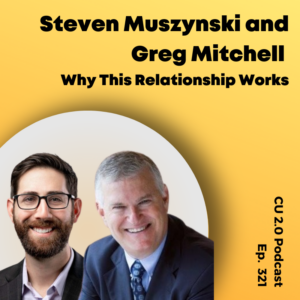Credit unions often lag competitors, technologically. Technological needs must be balanced with service, growth, and profit; often, those needs compete with fintechs, compliance, IT security, and ever-changing regulations.
Fortunately, credit unions have access to data—sometimes, that includes data from other credit unions. Yet, having data and leveraging it are two completely different issues.
That’s where data analytics comes in. Data can provide insights, drive efficiency, solve specific problems, and power digital transformation. If your credit union is getting into data analytics—or switching providers—this post is for you.
Check out our new downloadable Credit Union Provider Guides here!
Why You Need a Data Analytics Provider
From checking and savings account data to mortgages, auto loans, HELOCs, credit cards, and insurance… and email correspondence, branch visits, social media comments, call center disputes… member survey data, geographical location, demographics, credit scores…
At some point, it’s best to understand who your members are, what they want, and what they’re eligible for. You’ll learn who’s at risk of attriting, who wants a better credit card, and who’s eligible for a mortgage refinance.
Operations, marketing, HR, lending, and other departments can all use this information to create a better, more engaging, more relevant, and more rewarding member experience.
But to make positive changes, they need that information. And that information comes from data analytics.
Data analytics providers can help you aggregate, clean up/normalize, store, process, and use your data. They’ll show you what your credit union looks like now, what it will look like on its current trajectory, and even what you should do to change it. And, to make it easy, they’ll give you charts, graphs, and other visualizations and reports to make the data easy to understand and act on.
Decisions based on guesswork can get you pretty far—especially if the guesswork is done by a longtime industry professional with a keen eye to the future and the influence of technology. But decisions based on information will always be superior to guesswork.
Data analytics providers will allow your credit union to make informed decisions and transform your credit union, from the internal culture, to your roadmap, to the member experience.
Evaluating Credit Union Data Analytics Providers
There are many ways to evaluate data analytics providers. Especially if you’re just starting your data analytics journey, your first step should be to figure out what you want to accomplish with analytics. Simply using data-driven technology isn’t a goal in and of itself—rather, goals are things like improving interchange income, increasing auto loan portfolio size, and reducing attrition.
You’ll need to figure out what kind of projects you plan to augment with analytics. Knowing your goals will help you choose the tools best for achieving them.
We’ve ranked data analytics vendors by 3 different variables:
- Data governance and sophistication
- Normalization and composability
- Descriptive, predictive, and prescriptive abilities
- Connections and integrations
- Support
- Training, support, or management
- Access to existing models
- Credit union focus and understanding
- Ease of use
- Time to deploy and gain insight
- UX/UI and ease of use
- Visualization and reporting
This guide is designed to help you review data analytics providers in key categories. We also recommend asking these questions to evaluate potential data analytics providers.
With or Without a Data Warehouse…
We’ve separated vendors into two major categories: those that provide a data warehouse (thus offering scalability and a single source of truth), and those that don’t (providing spot solutions with your data).
We think of these as holistic and targeted solutions, respectively. Holistic solutions with a warehouse provide more flexibility for the future—you can build, buy, or borrow spot solutions as needed. Targeted solutions without a warehouse offer more focused guidance for specific strategic concerns. Hybrid approaches are possible!
If your goal is long-term growth, we generally recommend warehouse solutions. Getting the infrastructure, owning your data, and understanding the process is key to developing a data-driven culture. Plus, when you send away for analytics, it gets manipulated and merged, and you lose the source of your data.
One caveat is that we recommend against buying a data warehouse from a company that doesn’t specialize in data warehousing. Sure, it might work and be cheap, but it’ll lack in quality and won’t support your long-term success.
There are also non-warehouse solutions. For smaller credit unions, or those who simply need a few quick answers or solutions, and those who don’t want to develop a data-driven culture, non-warehouse solutions are still a good option. You can get actionable insights with minimal work and often with far less time invested up front.
You may also note that we didn’t include providers such as Amazon, Azure, Google, or Snowflake. Although these solutions are technically superior, they have a few major drawbacks:
- They aren’t designed for financial institutions;
- They don’t have integrations or connections with common third-party tools for credit unions; and
- Most credit unions don’t have the in-house expertise to implement, maintain, and maximize the investment in these solutions.
Lastly, it should be noted that some larger providers with massive product suites may be trickier to integrate with products from other vendors. For example, JHA and Fiserv integrate well with other JHA and Fiserv products. However, integrations outside of their product suite can be far less straightforward. For this reason, we typically prefer vendors that specialize heavily or exclusively in data analytics and who are dedicated to credit unions.
See more ways to evaluate data analytics providers in our downloadable 2.0 Guide here.
Data Analytics Vendor Guide (with Warehouse)
| Governance | Support | Ease | Description | |
| Alogent | 3 | 1 | 2 | Alogent’s AWARE platform provides powerful visualization and reporting to the mix with its focus on business intelligence. |
| Arkatechure Arkalytics | 3 | 3 | 3 | Arkalytics is the only data analytics platform with a warehouse, data lake, and fully managed services to transform your credit union’s strategy into actionable results. |
| Aunalytics | 3 | 2 | 3 | Aunalytics and their Daybreak warehouse are easy to use and undertand, and despite their broad industry reach, they have credit union experience. |
| CU*Answers Asterisk Intelligence | 3 | 2 | 2 | CU*Answers is a CUSO that provides a host of critical products alongside its Asterisk Intelligence data analytics solution. |
| Fiserv iVue | 3 | 2 | 2 | iVue is Fiserv’s sophisticated data analytics warehouse solution that provides broad data capabilities in conjunction with their other products. |
| IBM Data Warehouse | 3 | 1 | 1 | IBM provides world-leading data management solutions with AI capabilities for enterprise-level clients. |
| Jack Henry & Associates | 3 | 2 | 2 | Technically, Jack Henry & Associates now uses IBM’s data warehouse in conjunction with its own strategy and support team. |
| Lodestar Technologies | 3 | 3 | 3 | Lodestar Technologies offers a very competitive solution with fantastic visualization and reporting. |
| TIBCO Software | 3 | 1 | 2 | TIBCO Software is a business intelligence software provider with data analytics solutions for credit unions. |
| Trellance | 3 | 3 | 3 | Trellance increased their capabilities and support through its acquisition of CU Rise and OnApproach, including their M360 App Store. |
| The Knowlton Group VeriCU Data Lakehouse | 3 | 3 | 3 | The Knowlton Group’s VeriCU Data Lakehouse can be augmented by extensive auxiliary strategy and support services to fill in gaps and help you scale. |
| DIY (do it yourself) | * | * | * | The DIY route is the most difficult and expensive solution, but with enough resources, it can also be the best and most well-suited to your specific needs. |
Data Analytics Vendor Guide (No Warehouse)
| Governance | Support | Ease | Description | |
| Altair | 3 | 2 | 2 | Altair provides data management and analytics solutions to many industries, including credit unions under $100m in assets. |
| AUX Cuery | 3 | 3 | 3 | AUX’s Cuery uses TIBCO Software’s platform and THRIVE Strategic Services to provide a comprehensive and cost-effective solution for credit unions under $1b in assets. |
| BankBI | 3 | 2 | 2 | BankBI used to power AdvantEdge Digital, and their powerful business intelligence suite comes with CU-ready models. |
| Callahan & Associates | 3 | 2 | 2 | Callahan & Associates includes broader industry data from both banks and credit unions to augment its insights. |
| Datava | 3 | 3 | 3 | Datava offers a strong suite of data analytics and business intelligence with its marketing, communications, and member experience platform. |
| Deep Future Analytics | 2 | 2 | 2 | Deep Future Analytics specializes in CECL and loan modeling. |
| nCino (Visible Equity) | 3 | 2 | 2 | nCino includes data analytics and advanced business intelligence alongside its larger product suite. |
| Fiserv Prism | 3 | 2 | 2 | Fiserv’s Prism is a web-based auxiliary data solution that works well with its other data products. |
| Raddon | 2 | 2 | 2 | Raddon’s data analytics offering offers a comprehensive suite of services, but in limited quantity as parter of a broader product mix. |
| Temenos | 2 | 2 | 2 | Temenos includes advanced analytics and AI in its digital banking platform. |
| Saggezza TruVantage | 3 | 2 | 2 | Saggezza’s TruVantage leverages years of telecom big data experience to provide a lightweight data analytics platform for financial institutions. |
| TerraStrat | * | * | * | TerraStrat provides data science as a service (DSaaS), acting as an analytic extension of the credit union’s team. |
| Twenty-Twenty Analytics | 3 | 3 | 3 | Twenty-Twenty Analytics complements their competitive data analytics platform with fantastic visualization and reporting. |
| DIY (do it yourself) | * | * | * | The DIY route is the most difficult and expensive solution, but with enough resources, it can also be the best and most well-suited to your specific needs. |
Data Analytics Criteria Definitions
This section goes into detail about the metrics by which we ranked the data analytics criteria above. Our scale measures from 1–3, with 1 meaning “not great,” 2 meaning “average or good,” and 3 meaning “great or market leading.” Scores of 0 are possible, but they likely mean the provider doesn’t provide a critical component of the criteria.
1. Data governance and sophistication
Normalization of data is critical. Essentially, this is the quality and integrity of data. Is it well organized? Is it accurate? Is it accessible? And, is it… extensive?
If you’re going to make data-driven decisions, then you want good data. Think of normalization as the performance of your data.
Composability is also key. In short, this is how easy your data is to work with. If you think of your data as a sandbox of possibilities, you can create more solutions with composable, wet sand than you could with messy, dry sand.
Descriptive, predictive, and prescriptive analytics fit different needs. Descriptive analytics are table stakes—any provider should be able to give you insight about what’s happening with your members and at your credit union. Predictive analytics will help you with issues like CECL. And prescriptive analytics are that cherry on top that tells you what actions to take based on what the data reveals. The ability to handle all three types of analytics is fantastic, but not standard.
Connections and integrations ensure you can use data from multiple sources. If you want to use member survey data, CRM data, and other non-core sources of data, you’ll want a provider that can work with as much of your tech stack as possible.
2. Support
Training, support, and management can be the difference between a vendor you love and a vendor you hate. Does the vendor train you on how to use their solution? Do they provide that training to all staff who need it? Is the training long enough, and is it hands-on or through cumbersome videos and instruction manuals? Are they invested in your success, or do they leave you to your own devices after you cut the check?
Additionally, attentive, ongoing support is a plus. And finally, is the vendor is willing or able to manage your data platform, in whole or in part? It’s rare, but we love the flexibility that provides for credit unions under the $10b mark.
Access to existing models is absolutely necessary. You’ll be better served by a provider that can get you up and running quickly with the solutions you need. Loan origination models, predictive analytics for CECL, marketing segmentations and solutions, KPIs for loan officers…
If every vendor you speak with has existing solutions, make sure they have relevant experience addressing your short- and long-term goals.
Finally, a focus on and understanding of credit unions is key. Many data analytics providers serve a broad range of industries or financial institutions. But credit unions have different cultures, goals, and needs than others—your vendor should be familiar with them.
We prefer vendors that prioritize credit unions, and we particularly appreciate CUSOs over major fintechs that shoehorn data analytics into much larger product suites.
3. Ease of use
Time to deploy and gain actionable insight is a big consideration. Financial technology is evolving rapidly, and machine learning and other AI are accelerating that. The longer it takes to implement a data analytics solution, the further behind your credit union gets.
However, while we give points for speed, it’s not the most critical component here. Solutions without warehouses, training, and thorough onboarding processes will be slower… and won’t be as comprehensive or scalable.
UI/UX and general ease of use are important. Although ongoing training, support, and management can make bad UI/UX or complicated platforms bearable, you’ll get a lot more out of something that looks good and feels intuitive. You’ll also be able to train new employees faster and more effectively.
At the end of the day, it’s better to want to use the platform rather than have to.
Visualization and reporting should not be underrated.
Most people are not data scientists. Instead, they rely on intuitive user interfaces, dashboards, and visuals to understand data. Is the data readable? Is it accessible? Does the readout make sense to the people using it?
Data analytics vendors that report data in intuitive, intelligible, comprehensive ways will make it easier on your team. You’ll spend less time wondering what the numbers mean, and more time deciding what the numbers are saying. And “time” is key here—if you’re running dozens of reports per month, you’ll want that process to be simple and effective as possible (automation and good design can work wonders)!
Don’t Forget Your Data Strategy
Many of the vendors listed here will help you with your data strategy. However, not all of them will be there to guide you from Point A to Point Z the way Arkatechture’s Arkalytics team will, for example.
If you’re working with a more hands-off provider, a vendor without a warehouse and/or strategy solution, or you’ve decided to go the DIY route, then do this:
Bring on a data strategy consultant.
Many of the vendors above will include data strategy as an add-on service. Their add-on services will be pretty good because those consultants will be familiar with the platform you’ve chosen.
However, we’d also recommend looking for an independent consultant, such as Anne Legg of THRIVE Strategic Services (she literally wrote the book on credit union data analytics strategy). Anne Legg has helped hundreds of credit unions understand and build out mature data analytics programs. She’s also spoken at many of our events, and she is always a hit.
Conclusion
There are several vendors to compare, here. And we’ve certainly included enough metrics by which to measure their platforms and services.
The first step is to narrow down the list to a few who look promising to your credit union. Then, we recommend finding vendors who hit your criteria and doing further research. It’s important to choose a data analytics vendor who fits your credit union’s needs and project goals.
After you’ve narrowed your list, it’s time to do some demos and move forward. Read our blog here to see what questions you should ask potential data analytics providers. (It also includes recommendations of our favorite vendors!)




